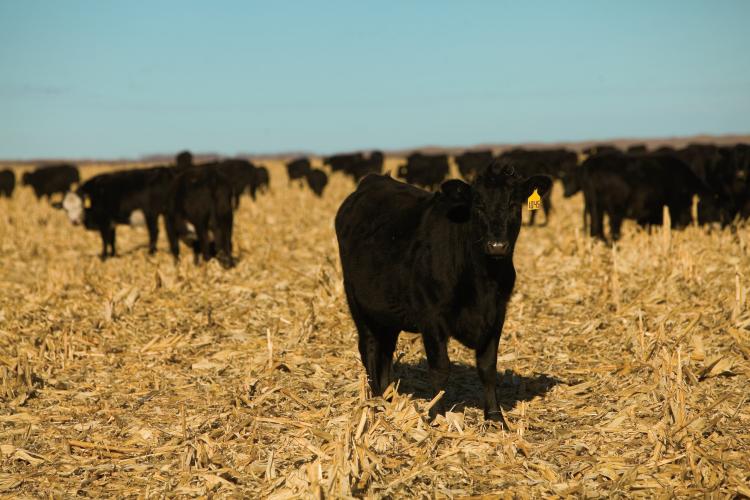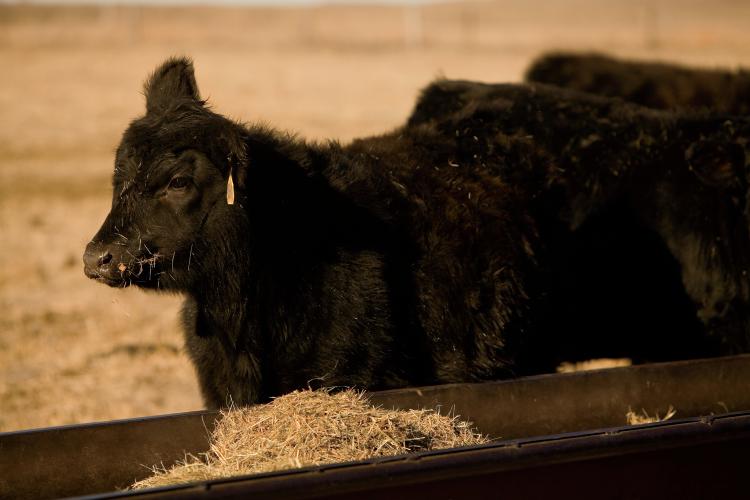Home > Nebraska > Nebraska Crops & Livestock > Nebraska Steers the Way in Beef Production
Nebraska Steers the Way in Beef Production

Cattle outnumber people by about four to one in Nebraska, so it should be no surprise to learn that the production of beef is big business in the state. Every step of the process is located here, from the farm gate to the dinner plate, and that makes the sector a leading contributor to the Nebraska economy, as well as a critical piece of Nebraska’s agricultural heritage.
This results in the best beef you can get, according to Michael Kelsey, executive vice president of Nebraska Cattlemen.
“Our state’s history is tied to cattle production,” Kelsey says. “And the factors that made raising cattle here attractive in the mid-1800s are still relevant today. We have the natural resources, the cattle genetics, the central location and the people that come together to support our state’s economy, from the ranches to the feedlots to the processors.”
Location, Location, Location
The process all starts on the farms and ranches where the cattle are born, and the state’s ideal geographic landscape provides the perfect backdrop. Cattle are raised in each of the state’s 93 counties, but the north central part of the state is an especially good location, Kelsey says.
“I’m not sure there’s a better place in the world to raise a cow than in Nebraska’s Sandhills. And it’s great because the cows don’t have to travel far for processing,” he says.
Homer Buell, who runs a cow-calf operation in the Sandhills near Bassett, agrees. “The state’s topography is ideal for the entire beef production system,” explains Buell. “The eastern part of Nebraska has good cropland for corn that is primary for fattening cows, while the rest of the state has great grasslands. If you go to farming states like Iowa and Illinois, they have the corn but not the grasslands. Nebraska has all the ingredients that allow us to have a profitable beef industry.”
There are 23 million acres of range and pasture lands in Nebraska, including Buell’s Shovel Dot Ranch, which has been in the family since 1883. Today, his Angus ranch raises and sells steers (male cattle raised for beef) once they reach weights of about 900 pounds, while heifers (female cattle that haven’t borne a calf) are sold at 850 pounds.
“Cows graze in our pastures throughout the year, plus we grow enough crops where we don’t have to feed a lot of hay,” Buell says.
It is evident that Nebraska thrives in cow-calf production when it is compared to such production in other states. Three Nebraska counties – Cherry, Custer and Holt – rank as the top three cow counties in the nation, home to a combined 365,000 head of cattle. The state’s 20,000 cattle ranches average about 94 head per herd, more than twice the national average.
Kelsey points out that despite the vast number of cattle, more than 99 percent of these operations are family-owned and operated.

Raising the Steaks
While some cattle remain on pastures until processing, many calves, once they get to weaning weight, are sold from the farm or ranch where they were born to a finishing feedlot. Nebraska has about 4,500 feedlots, where calves eat a mixture of corn, dried distillers grains (a byproduct of ethanol), hay and other forages until they reach market weight. Market weight is generally about 1,300 pounds.
J.D. Alexander, whose family started Alexander Cattle & Farms in Pilger during the 1940s, says he can’t imagine running his business anywhere else.
“Nebraska is the perfect spot for the cattle industry in the United States,” says Alexander. “Farming, ranching, backgrounding, finishing feedlots and packing plants – we have it all, including the Ogallala aquifer, which is vital to our irrigation of crops.”
Alexander’s family-owned operation, which includes a feedlot, is located in northeastern Nebraska. For the feedlot sector of the beef production industry, being in a state with strong grain and ethanol production is a great benefit, Alexander says.
“The grain, ethanol and cattle production sectors all work together in a way that provides economic advantages for Nebraska that other states miss out on,” Alexander says.

Meat the Best
Once cattle get to market weight, they then go to local processors, which are scattered throughout the state in communities such as Omaha, Schuyler, Gibbon and Lexington.
One of those processors, Greater Omaha Packing Co. Inc., was founded in 1920 and currently provides nearly 900 jobs in Omaha. All of its cattle arrive from within 150 miles of the city.
“The cattle we handle are either Angus or Hereford beef, with every animal corn-fed, well-marbled and deserving of some of the highest grades for choice meats,” says Angelo Fili, executive vice president of Greater Omaha Packing. “We work closely with the University of Nebraska to keep up with the latest trends for top muscle cuts, thereby supplying the most tender meat to customers,” Fili adds.
There are seven federally-inspected beef processing facilities with over 500 employees each in Nebraska, and dozens of others of varying sizes handling beef or other meats. All must meet strict standards that are enforced by the Food Safety and Inspection Service of the United States Department of Agriculture.
“Our goal is to get the best quality cattle to produce the best quality beef for our customers here and abroad,” Fili says. “Nebraska beef is known nationally and internationally for quality. I think all sectors of the industry want to maintain that reputation.”
“America is the international leader in agriculture, and Nebraska is a national leader in many areas,” says Fili. “Nebraska doesn’t have oceans or palm trees – we have agriculture that includes a strong beef industry.”

Healthy Economy
Beef helps keep the state’s economy healthy by securing jobs for Nebraskans. Kelsey points out that one out of every four jobs in Nebraska are in or related to agriculture, and the beef industry is a major contributor.
“It’s not just about the jobs directly provided by the rancher, the feedlot owner and the beef processor,” Kelsey says. “All these sectors utilize veterinary care, trucking companies, bankers and accountants. This keeps the economy healthy and provides a tremendous amount of employment in Nebraska.”
As for the future of Nebraska beef, Kelsey says it is very promising. “With the abundance of raw materials that we have, I think consumers can continue to be assured that beef will stay in Nebraska and will keep supporting our economy with jobs and a healthy product.”



